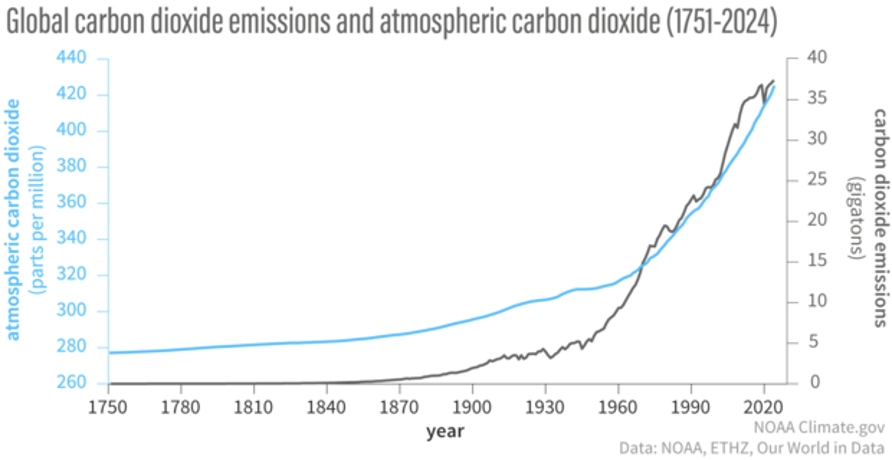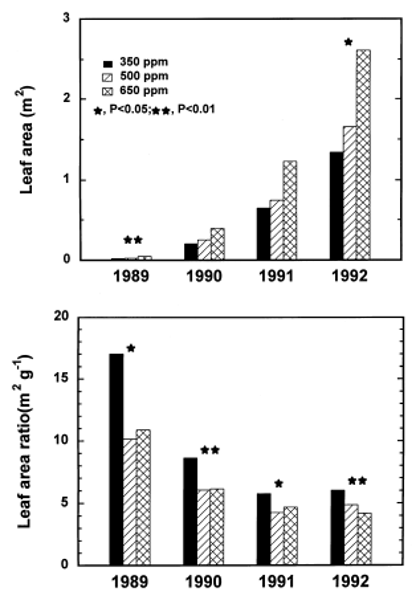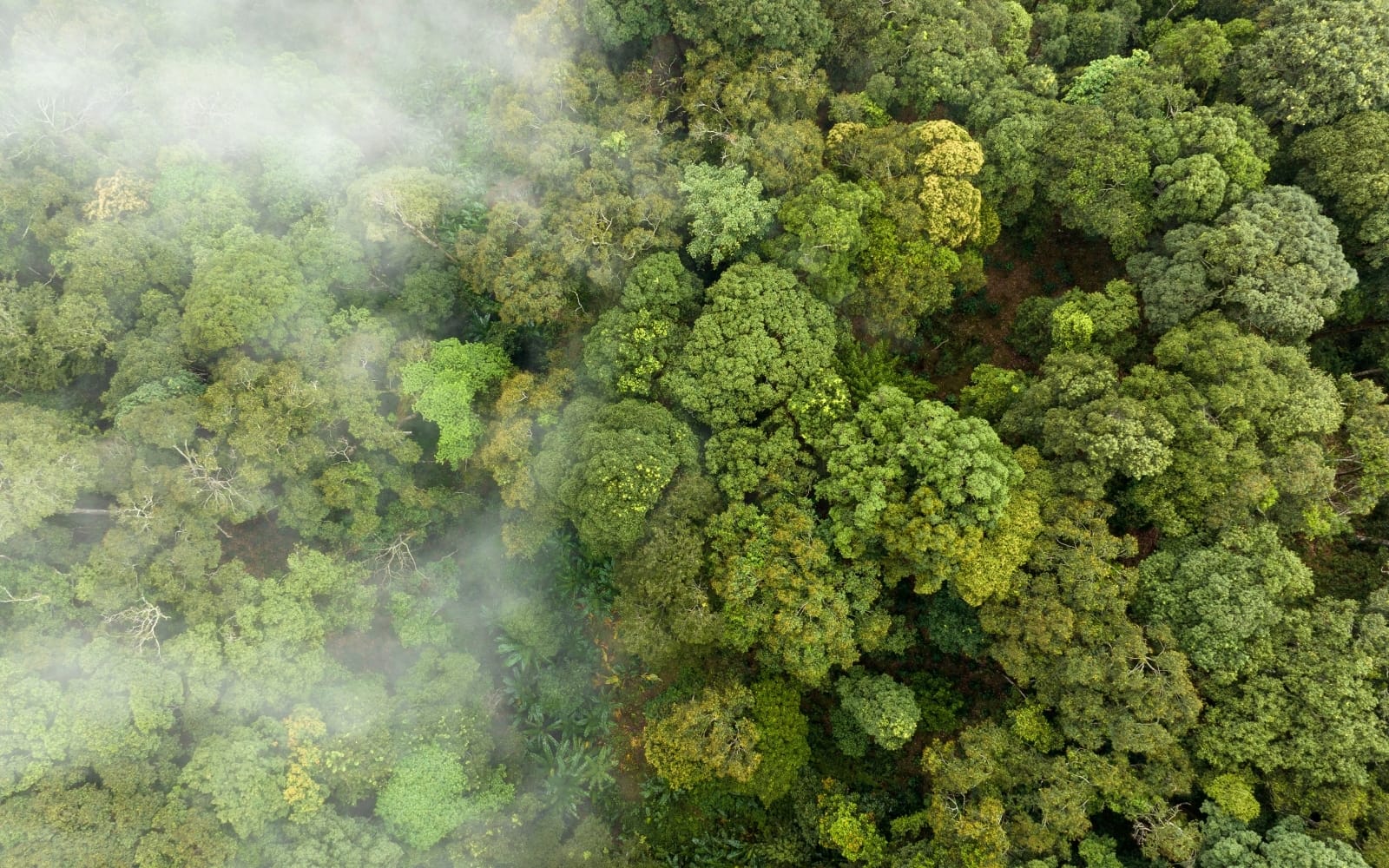October 20, 2025 at 5:17 pm | Updated October 20, 2025 at 5:17 pm | 8 min read
- Leaf area increase is a consistent vegetation response to elevated carbon dioxide levels in the atmosphere.
- The increase in leaf area declines due to long-term exposure of vegetation to carbon dioxide.
- Various intrinsic and external factors moderate the increase in leaf area due to elevated carbon dioxide.
Elevated carbon dioxide concentrations from anthropogenic sources are affecting various aspects of vegetation. Leaves are the plant organs that absorb carbon dioxide, so changes in leaf area can have cascading effects on plant functioning and productivity. This article looks at what we know about the impact of elevated carbon dioxide on leaf area.
Rising Carbon Dioxide Levels

Figure 1: “The amount of carbon dioxide in the atmosphere (blue line) has increased along with human emissions (gray line) since the start of the Industrial Revolution in 1750. Emissions rose slowly to about 5 gigatons (1 gigaton is 1 billion metric tons per year) in the mid-20th century before rapidly increasing to more than 35 billion tons per year by the end of the century,” Lindsey and Miller (2025). (Image credits: https://www.climate.gov/news-features/understanding-climate/climate-change-atmospheric-carbon-dioxide)
Subscribe to the CID Bio-Science Weekly article series.
By submitting this form, you are consenting to receive marketing emails from: . You can revoke your consent to receive emails at any time by using the SafeUnsubscribe® link, found at the bottom of every email. Emails are serviced by Constant Contact
Carbon dioxide (CO2) levels have increased since the Industrial Revolution, primarily due to the widespread use of fossil fuels such as coal and oil for energy, see Figure 1. According to NOAA’s Global Monitoring Lab, in 2024, new global highs of 422.7 parts per million (ppm) were recorded. CO2 levels continue to rise in this century and can reach 800 and 1,100 ppm by 2100, depending on the emissions and mitigation efforts.
Research since the 1990s has shown that an increase in CO2 levels to ≈ approximately 650–700 ppm is increasing leaf area, photosynthesis, and biomass in plants across various crop and forest species, but reduces leaf nutrient content.
Leaf Area Increases

Figure 2: “Leaf area and leaf area ratio (leaf area divided by above-ground plant dry mass) of Quercus alba trees grown in ambient and elevated CO2,” Norby et al. (2002). (Image credits: https://onlinelibrary.wiley.com/doi/full/10.1046/j.1365-3040.1999.00391.x)
Increases in leaf area have been observed in crops and natural vegetation due to elevated CO2 levels. The results first demonstrated in pot experiments have been confirmed by later field studies conducted for the long-term effects of elevated CO2. The leaf area rises in annuals, such as herbs, and in woody species alike. The different means of leaf area augmentation can be achieved through increased leaf numbers or fascicles, an increase in flush length, and larger leaf size.
An increase in leaf area was observed in Citrus aurantium trees, with 78% more leaves, while the size increased by only 13%. It was higher fascicle numbers in Pinus sylvestris.
Moreover, CO2 fertilization effects are transitory. After an initial spurt in leaf area increase, there is a decline in the rate of growth.
Early pot experiments showed a decline in growth because containers constrained the root development. For example, Citrus aurantium trees grown at a considerable distance to avoid light competition showed a growth decline after three years in elevated CO2. However, the decline was also seen in trees growing in the ground. Pinus ponderosa trees that reached a closed canopy in six years showed a decrease in long-term exposure in open-top chambers. However, a decline in growth rate as woody species mature is part of their standard growth patterns, too.
Mechanisms Driving Leaf Area Increases
The increase in individual leaf area or total leaf area, resulting from more leaves, occurs due to anatomical and physiological causes, as discussed below.
Cell expansion
Both cell production and expansion are sensitive to CO2 concentrations, but it is cell expansion that increases leaf area as the gas concentration rises. However, the effects are moderated by the genotype and growth environment. An increase in leaf cell expansion occurs due to the boosted activity of the enzyme xyloglucan endo-transglycosylase, which loosens the cell wall and leads to higher turgor pressure.
Increase in photosynthesis
Increased photosynthesis and water use efficiency are factors that boost leaf area. Both C-4 and C-3 plants show an increase in leaf area. However, the increase is greater in C-3 plants, which have higher leaf area and thickness due to elevated CO2 levels. For the same amount of water lost, the increase in CO2 leads to more photosynthesis and increased biomass production. Whereas C-4 plants already possess a CO2 concentrating mechanism, the benefits are therefore less pronounced. The increase in biomass results in a greater allocation of carbon for higher leaf production or leaf expansion.
The increase in leaf area is influenced by various intrinsic and external factors that explain the differences in response shown by plants.
Factors Affecting Leaf Area Increases
Some factors influencing the increases in leaf area due to CO2 fertilization include species, growth stage, initial plant size, time of day, and climate.
Species of plants
The extent of increase also depends on the species. For example, seedlings and saplings of Pinus taeda showed a 41% increase in leaf area, while Populus clones only showed an 8-18% increase, in elevated CO2 atmospheres compared to ambient control conditions. Pine trees in forests can increase leaf area only when grown in moderately fertile sites. In contrast, broadleaved temperate trees, such as beech, which have low stomatal conductance and low CO2 concentrations in their leaves, generally show increased leaf area due to elevated CO2 levels. However, the stimulating effect on leaf area reduces with prolonged exposure to CO2.
Growth stage
Younger trees, still growing, exhibit a greater response to elevated CO2. Leaf area increases are substantial in younger trees that are not limited by closed canopies and a “steady-state leaf area index” and produce more biomass. These increases in leaf area have been observed in seedlings in pots and open-top chambers, with no reduction due to long-term exposure to elevated CO2. Tree seedling growth increases are sustained even in nutrient-deficient conditions, despite being accompanied by lower photosynthesis efficiency and foliar nutrient concentrations.
Size
Among the growing plants, size matters. Larger plants with more stems and leaves, which had a higher capacity to absorb and fix CO2, were able to grow more leaf area. Any factor, such as growing conditions or management, that produced differences among individuals within a species, giving them an early boost in leaf area, resulted in magnified benefits later.
If there are no constraints, increases in leaf area can be significant. However, in forests, the availability of nutrients, water, and light is not limitless, and leaf area increases slowly and then stops.
Time of the day
Plants are exposed to elevated CO2 levels day and night. There is no clear consensus yet that nighttime exposure to CO2 increases leaf area, despite the accepted fact that it improves plant growth. Most experiments use CO2 enrichment during the daytime, and studies exposing plants to CO2 at night are relatively recent. One survey by Bunce (2003) showed that leaf area increased in four chalk grassland herbs, but Baker et al (2022) found that cotton seedlings did not show increased leaf area or plant growth due to nighttime exposure to CO2.
Climate and growing conditions
The effect of elevated CO2 on increasing photosynthesis varies depending on the availability of water and the climate. Long-term experiments show that net ecosystem productivity depends on annual rainfall. The effect of precipitation on photosynthesis under elevated CO2 is moderated by vegetation type. Woody species can increase productivity more effectively than grassland species. The result is a higher leaf area index in woody species (23%) compared to grassland species (13%).
Increasing the temperature up to 28°C boosts leaf area. Beyond these temperatures, annual plants like Amaranthus retroflexus and Abutilon theophrasti couldn’t benefit from the higher CO2 levels in the atmosphere. At 38°C, both individual and branch leaf areas decreased, which was reflected in lower biomass accumulation.
Leaf area increases due to elevated CO2 is constrained by a deficiency in soil water or nutrients in some instances. Pine trees in forests can increase leaf area when grown in moderately fertile sites. The trees cannot respond to higher CO2 levels in the air when they are in sites with little nutrients or very fertile soils.
Studying Leaf Area Changes
Changes in leaf area can affect many physiological plant functions, such as transpiration and photosynthesis, with implications at ecosystem scales. The mechanistic causes of changes in leaf area are also not completely understood. These require field studies at the local scale, where precision instruments can be helpful. CID BioScience Inc. offers two instruments – the CI-202 Portable Laser Leaf Area Meter and the CI-203 Handheld Laser Leaf Area Meter for non-destructive leaf area measurements. These precision instruments, which can be used on-site to provide real-time results, can save scientists time in data collection and analysis and expedite experiments.
Find out more about CID BioScience Inc’s leaf area meters for your research.
FAQ
1. How does elevated carbon dioxide affect leaf area in plants?
Elevated CO₂ typically increases leaf area across many plant types, including crops and forests. This occurs through greater photosynthesis efficiency and enhanced cell expansion, allowing plants to produce larger or more numerous leaves. However, the effect isn’t limitless, long-term exposure often leads to a decline as plants adapt or encounter environmental constraints such as nutrient or water shortages.
2. Why does the increase in leaf area eventually decline over time?
The “CO₂ fertilization effect” is transient. Initially, plants respond with vigorous growth, but as canopies close and resources like soil nutrients or water become limiting, growth slows. In mature forests, this slowdown also aligns with standard aging patterns where leaf area and growth stabilize regardless of CO₂ levels.
3. What factors influence how much a plant’s leaf area increases under elevated CO₂?
Several intrinsic and environmental factors determine the degree of increase, including:
Species type: C₃ plants (like broadleaf trees) tend to show stronger responses than C₄ species.
Growth stage: Young plants and seedlings respond more than mature ones.
Climate conditions: Temperature, rainfall, and nutrient availability all affect how long the boost lasts.
Day vs. night exposure: While daytime CO₂ enrichment boosts leaf growth, nighttime exposure has mixed results across species.
Sources
Ackerly, D. D., Coleman, J. S., Morse, S. R., & Bazzaz, F. A. (1992). CO_2 and Temperature Effects on Leaf Area Production in Two Annual Plant Species. Ecology, 73(4), 1260-1269. https://doi.org/10.2307/1940674
Baker, J. T., Lascano, R. J., Yates, C., & III, D. C. G. (2022). Nighttime CO2 enrichment did not increase leaf area or shoot biomass in cotton seedlings. Agricultural and Forest Meteorology, 320, 108931. https://doi.org/10.1016/j.agrformet.2022.108931
Cordak, A. S., Kooperman, G. J., Zarakas, C. M., S. Swann, A. L., & Koven, C. D. (2025). The Role of Leaf Area Changes Within Plant CO2 Physiological Impacts on the Global Hydrological Cycle. Geophysical Research Letters, 52(2), e2024GL110904. https://doi.org/10.1029/2024GL110904
Epron, D., Liozon, R., & Mousseau, M. (1996). Effects of elevated CO2 concentration on leaf characteristics and photosynthetic capacity of beech (Fagus sylvatica) during the growing season. Tree Physiology, 16 (4), 425–432. https://doi.org/10.1093/treephys/16.4.425
Lindsey, R. (2025, May 21). Climate change: atmospheric carbon dioxide. Retrieved from https://www.climate.gov/news-features/understanding-climate/climate-change-atmospheric-carbon-dioxide
Manzoni, S., Fatichi, S., Feng, X., Katul, G. G., Way, D., and Vico, G. (2022). Consistent responses of vegetation gas exchange to elevated atmospheric CO2 emerge from heuristic and optimization models. Biogeosciences, 19, 4387–4414, https://doi.org/10.5194/bg-19-4387-2022, 2022.
McCarthy, H. R., Oren, R., Finzi, A. C., Ellsworth, D. S., Kim, S., Johnsen, K. H., & Millar, B. (2007). Temporal dynamics and spatial variability in the enhancement of canopy leaf area under elevated atmospheric CO2. Global Change Biology, 13(12), 2479-2497. https://doi.org/10.1111/j.1365-2486.2007.01455.x
Norby, R. J., Wullschleger, S. D., Gunderson, C. A., Johnson, D. W., & Ceulemans, R. (1999). Tree responses to rising CO2 in field experiments: implications for the future forest, Plant Cell Environ., 22, 683–714, 1999. https://doi.org/10.1046/j.1365-3040.1999.00391.x
Pan, Y., Jackson, R. B., Hollinger, D. Y., Phillips, O. L., Nowak, R. S., Norby, R. J., Oren, R., Reich, P. B., Lüscher, A., Mueller, K. E., Owensby, C., Birdsey, R., Hom, J., and Luo, Y. (2022). Contrasting responses of woody and grassland ecosystems to increased CO2 as water supply varies. Nat. Ecol. Evol., 6, 315–323, https://doi.org/10.1038/s41559-021-01642-6
Peñuelas, J., & Matamala, R. (1990). Changes in N and S Leaf Content, Stomatal Density and Specific Leaf Area of 14 Plant Species during the Last Three Centuries of CO2 Increase. Journal of Experimental Botany, 41(9), 1119-1124. https://doi.org/10.1093/jxb/41.9.1119
Prior, S. A., Pritchard, S. G., & Runion, G. B. (2004). Leaves and the effects of elevated carbon dioxide levels. Dekker Encyclopedia of Plant and Crop Science, 648-650.
Taylor, G., Ceulemans, R., Ferris, R., Gardner, S. D., & Shao, B. Y. (2001). Increased leaf area expansion of hybrid poplar in elevated CO2. From controlled environments to open-top chambers and to FACE. Environmental pollution (Barking, Essex : 1987), 115(3), 463–472. https://doi.org/10.1016/s0269-7491(01)00235-4
Related Products
Most Popular Articles
- Transpiration in Plants: Its Importance and Applications
- Leaf Area – How & Why Measuring Leaf Area…
- How to Analyze Photosynthesis in Plants: Methods and Tools
- Plant Respiration: Its Importance and Applications
- The Forest Canopy: Structure, Roles & Measurement
- Stomatal Conductance: Functions, Measurement, and…
- Forest & Plant Canopy Analysis – Tools…
- Root Respiration: Importance and Applications
- The Importance of Leaf Area Index (LAI) in…
- Irrigating with Saline or Seawater






